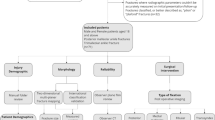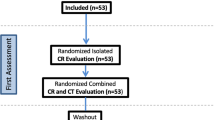Abstract
Objective
Radiographs are first-line imaging in ankle trauma but lack sensitivity to detect ligamentous injuries and undisplaced fractures. Our hypothesis was that ankle injuries occur in predefined sequences along two osteoligamentous rings, so that occult injuries non-visible on initial radiographs can be predicted. We, therefore, aimed to validate a ring model of progressive damages in the interpretation of ankle trauma radiographs.
Methods
This study retrospectively enrolled 277 adult patients that presented an acute fibular fracture on ankle radiographs between May and November 2019. Four different types of fibula fracture were differentiated, each being considered to correspond to a different mechanism of injury. Patients were classified into four groups, upon the appearance of their fibular fracture. Then, injuries to the distal tibiofibular syndesmosis, medial malleolus, and deltoid ligament (medial clear space) were assessed in each patient radiographs. Traumatic injuries were independently evaluated by a resident and an experienced MSK radiologist. For each patient, observed features were compared to those predicted by the ring concept. Inter- and intraobserver agreements were calculated.
Results
Injuries were observed according to the predictable sequence in 266 of the 277 patients (96%). In the 11 remaining patients, discordances were presumably due to undisplaced injuries to the syndesmosis or deltoid ligament. Agreements were considered very good for each evaluated item.
Conclusion
The Lauge-Hansen ring concept was found to be highly accurate and reproducible for radiographic assessment of ankle injuries. Discordances to the predicted sequence might reflect occult injuries, especially of the syndesmosis or deltoid ligament.






Similar content being viewed by others
Abbreviations
- AITFL:
-
Anteroinferior tibiofibular ligament
- MCS:
-
Medial clear space
- MOI:
-
Mechanisms of injury
- PER:
-
Pronation, external rotation
- PITFL:
-
Posteroinferior tibiofibular ligament
- SER:
-
Supination, external rotation
- SAD:
-
Supination, adduction
- PAB:
-
Pronation, abduction
- TFCS:
-
Tibiofibular clear space
- TFS:
-
Tibiofibular syndesmosis
References
Barnett CH, Napier JR. The axis of rotation at the ankle joint in man; its influence upon the form of the talus and the mobility of the fibula. J Anat. 1952;86(1):1–9.
Funk JR. Ankle injury mechanisms: lessons learned from cadaveric studies. Clin Anat. 2011;24(3):350–61.
Michelson JD. Ankle fractures resulting from rotational injuries. J Am Acad Orthop Surg. 2003;11(6):403–12.
Lauge-Hansen N. Fractures of the ankle. II. Combined experimental-surgical and experimental-roentgenologic investigations. Arch Surg. 1950;60(5):957–85.
Lauge-Hansen N. Fractures of the ankle. IV. Clinical use of genetic roentgen diagnosis and genetic reduction. AMA Arch Surg. 1952;64(4):488–500.
Lauge-Hansen N. Fractures of the ankle. III. Genetic roentgenologic diagnosis of fractures of the ankle. Am J Roentgenol Radium Ther Nucl Med. 1954;71(3):456–71.
Warner SJ, Garner MR, Hinds RM, Helfet DL, Lorich DG. Correlation between the Lauge-Hansen classification and ligament injuries in ankle fractures. J Orthop Trauma. 2015;29(12):574–8.
Phillips RS, Balmer GA, Monk CJ. The external rotation fracture of the fibular malleolus. Br J Surg. 1969;56(11):801–6.
Pankovich AM. Fractures of the fibula proximal to the distal tibiofibular syndesmosis. J Bone Joint Surg Am. 1978;60(2):221–9.
Okanobo H, Khurana B, Sheehan S, Duran-Mendicuti A, Arianjam A, Ledbetter S. Simplified diagnostic algorithm for Lauge-Hansen classification of ankle injuries. Radiographics. 2012;32(2):E71-84.
Hermans JJ, Wentink N, Beumer A, Hop WC, Heijboer MP, Moonen AF, Ginai AZ. Correlation between radiological assessment of acute ankle fractures and syndesmotic injury on MRI. Skeletal Radiol. 2012;41(7):787–801.
Mengiardi B, Pinto C, Zanetti M. Medial collateral ligament complex of the ankle: MR imaging anatomy and findings in medial instability. Semin Musculoskelet Radiol. 2016;20(1):91–103.
Deborde E, Bierry G. Ankle and distal tibia. In: Bierry G, editor. Skeletal trauma - a mechanism-based approach of imaging. London: Academic Press; 2021. p. 361–406.
Gardner MJ, Demetrakopoulos D, Briggs SM, Helfet DL, Lorich DG. The ability of the Lauge-Hansen classification to predict ligament injury and mechanism in ankle fractures: an MRI study. J Orthop Trauma. 2006;20(4):267–72.
Hanson JA, Fotoohi M, Wilson AJ. Maisonneuve fracture of the fibula: implications for imaging ankle injury. AJR Am J Roentgenol. 1999;173(3):702.
Hinds RM, Schottel PC, Berkes MB, Little MT, Helfet DL, Lorich DG. Evaluation of Lauge-Hansen designation of Weber C fractures. J Foot Ankle Surg. 2014;53(4):434–9.
White TO, Bugler KE. Ankle fractures. In: Court-Brown CM, Heckmann JD, McQueen MM, Ricci WM, Tornetta P, editors. Rockwood and Green’s fractures in adults. Philadelphia: Wolters Kluwer; 2015. p. 2541–92.
Gisev N, Bell JS, Chen TF. Interrater agreement and interrater reliability: key concepts, approaches, and applications. Res Social Adm Pharm. 2013;9(3):330–8.
Lambert LA, Falconer L, Mason L. Ankle stability in ankle fracture. J Clin Orthop Trauma. 2020;11(3):375–9.
Rammelt S, Bartonicek J, Kroker L, Neumann AP. Surgical fixation of quadrimalleolar fractures of the ankle. J Orthop Trauma. 2021;35(6):e216–22.
German J, Guillermo A, Rammelt S, Leandro C, Luciano M. Quadrimalleolar fractures of the ankle: think 360°—a step-by-step guide on evaluation and fixation. J Foot Ankle Surg (Asia Pacific). 2021;8(4):193–200.
Bolin H. The fibula and its relationship the tibia and talus in injuries of the ankle due to forced external rotation. Acta radiol. 1961;56:439–48.
Van Heest TJ, Lafferty PM. Injuries to the ankle syndesmosis. J Bone Joint Surg Am. 2014;96(7):603–13.
Donohoe S, Alluri RK, Hill JR, Fleming M, Tan E, Marecek G. Impact of computed tomography on operative planning for ankle fractures involving the posterior malleolus. Foot Ankle Int. 2017;38(12):1337–42.
Rammelt S, Bartonicek J, Neumann AP, Kroker L. Fractures of the anterolateral tibial rim: the fourth malleolus. Unfallchirurg. 2021;124(3):212–21.
Rammelt S, Boszczyk A. Computed tomography in the diagnosis and treatment of ankle fractures: a critical analysis review. JBJS Rev. 2018;6(12): e7.
Haraguchi N, Armiger RS. A new interpretation of the mechanism of ankle fracture. J Bone Joint Surg Am. 2009;91(4):821–9.
Boszczyk A, Fudalej M, Kwapisz S, Klimek U, Maksymowicz M, Kordasiewicz B, Rammelt S. Ankle fracture - correlation of Lauge-Hansen classification and patient reported fracture mechanism. Forensic Sci Int. 2018;282:94–100.
Rodriguez EK, Kwon JY, Herder LM, Appleton PT. Correlation of AO and Lauge-Hansen classification systems for ankle fractures to the mechanism of injury. Foot Ankle Int. 2013;34(11):1516–20.
Cabuk H, Celebi F, Imren Y, Dedeoglu SS, Kir MC, Uyanik AF, Gurbuz H. Compatibility of Lauge-Hansen classification between plain radiographs and magnetic resonance imaging in ankle fractures. J Foot Ankle Surg. 2018;57(4):712–5.
Nielsen JO, Dons-Jensen H, Sorensen HT. Lauge-Hansen classification of malleolar fractures. An assessment of the reproducibility in 118 cases. Acta Orthop Scand. 1990;61(5):385–7.
Verhage SM, Rhemrev SJ, Keizer SB, Quarles van Ufford HM, Hoogendoorn JM. Interobserver variation in classification of malleolar fractures. Skeletal Radiol. 2015;44(10):1435–9.
Rasmussen S, Madsen PV, Bennicke K. Observer variation in the Lauge-Hansen classification of ankle fractures. Precision improved by instruction, Acta Orthop Scand. 1993;64(6):693–4.
Liu Y, Lu H, Xu H, Xie W, Chen X, Fu Z, Zhang D, Jiang B. Characteristics and classification of medial malleolar fractures. Bone Joint J. 2021;103-B(5):931–8.
Birnie MFN, van Schilt KLJ, Sanders FRK, Kloen P, Schepers T. Anterior inferior tibiofibular ligament avulsion fractures in operatively treated ankle fractures: a retrospective analysis. Arch Orthop Trauma Surg. 2019;139(6):787–93.
Corte-Real N, Caetano J. Ankle and syndesmosis instability: consensus and controversies. EFORT Open Rev. 2021;6(6):420–31.
Vogl TJ, Hochmuth K, Diebold T, Lubrich J, Hofmann R, Stockle U, Sollner O, Bisson S, Sudkamp N, Maeurer J, Haas N, Felix R. Magnetic resonance imaging in the diagnosis of acute injured distal tibiofibular syndesmosis. Invest Radiol. 1997;32(7):401–9.
Rammelt S, Obruba P. An update on the evaluation and treatment of syndesmotic injuries. Eur J Trauma Emerg Surg. 2015;41(6):601–14.
Grossterlinden LG, Hartel M, Yamamura J, Schoennagel B, Burger N, Krause M, Spiro A, Hoffmann M, Lehmann W, Rueger JM, Rupprecht M. Isolated syndesmotic injuries in acute ankle sprains: diagnostic significance of clinical examination and MRI. Knee Surg Sports Traumatol Arthrosc. 2016;24(4):1180–6.
Lalezari S, Amrami KK, Tubbs RS, Spinner RJ. Interosseous membrane: the anatomic basis for combined ankle and common fibular (peroneal) nerve injuries. Clin Anat. 2012;25(3):401–6.
Mait AR, Forman JL, Nie B, Donlon JP, Mane A, Forghani AR, Anderson RB, Cooper MT, Kent RW. Propagation of syndesmotic injuries during forced external rotation in flexed cadaveric ankles. Orthop J Sports Med. 2018;6(6):2325967118781333.
Author information
Authors and Affiliations
Corresponding author
Ethics declarations
Conflict of interest
The authors declare no competing interests.
Additional information
Publisher's note
Springer Nature remains neutral with regard to jurisdictional claims in published maps and institutional affiliations.
Rights and permissions
About this article
Cite this article
Nicolai, C., Bierry, G., Faruch-Bilfeld, M. et al. The concept of ring of injuries: evaluation in ankle trauma. Skeletal Radiol 51, 2027–2037 (2022). https://doi.org/10.1007/s00256-022-04062-0
Received:
Revised:
Accepted:
Published:
Issue Date:
DOI: https://doi.org/10.1007/s00256-022-04062-0




